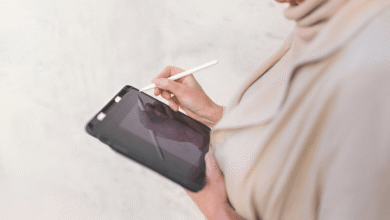Create a Healthy Digital Routine Without Going Offline
Healthy digital routine Discover 10 actionable tips to balance screen time, boost productivity & reduce digital stress without going offline.

In today’s always-connected world, maintaining a healthy digital routine is crucial for mental clarity, productivity, and overall well-being. While completely disconnecting from the internet isn’t realistic for most people, it’s entirely possible to develop mindful habits that minimize digital stress without going offline. A healthy digital routine helps you stay in control of your screen time, allowing you to harness the benefits of technology while avoiding burnout, distraction, and the negative effects of excessive use.
The key lies in intentional usage setting boundaries, optimizing how and when you engage with devices, and making technology work for you rather than against you. Whether you’re a professional, student, or simply someone looking to reduce digital fatigue, this guide will provide actionable strategies to help you create a sustainable balance. By the end, you’ll have the tools to stay productive, present, and mentally refreshed all while remaining connected in a way that enhances rather than disrupts your life.
Create a Healthy Digital Routine Without Going Offline
Understanding the Need for a Healthy Digital Routine
The digital age has revolutionized how we work, communicate, and entertain ourselves. However, excessive screen time has been linked to anxiety, poor sleep, and decreased productivity. A healthy digital routine helps mitigate these effects by encouraging mindful usage rather than complete avoidance. The key is balance acknowledging that technology is indispensable while ensuring it doesn’t dominate our lives. Whether you’re a student, remote worker, or social media enthusiast, adopting structured digital habits can improve focus, reduce burnout, and enhance overall well-being.
Setting Clear Digital Boundaries
One of the most effective ways to establish a healthy digital routine is by setting boundaries. Start by defining tech-free zones, such as the bedroom or dining area, to encourage offline interactions and better sleep. Schedule specific times for checking emails and social media rather than constantly refreshing feeds. Another useful strategy is implementing app limits. Most smartphones now offer features to track and restrict screen time. Setting daily limits for non-essential apps can prevent mindless scrolling and free up time for more meaningful activities.
Prioritizing Quality Screen Time
Not all screen time is equal. Passive consumption, like binge-watching or endless scrolling, often leaves us feeling drained. Instead, focus on active engagement learning new skills, connecting with loved ones, or working on creative projects. Consider curating your digital environment by unsubscribing from unnecessary notifications and following content that adds value. Replace time-wasting apps with educational podcasts, e-books, or productivity tools that align with your goals.
Incorporating Digital Detox Periods
While staying offline entirely isn’t feasible, short digital detoxes can reset your focus. Designate periods—such as mornings or weekends where you minimize screen use. Engage in offline hobbies like reading, exercising, or spending time outdoors. Even small breaks, like a 10-minute walk without your phone, can reduce digital fatigue. The goal isn’t to eliminate technology but to create space for mental clarity and real-world connections.
Optimizing Technology for Well-Being
Technology itself can support a healthy digital routine. Use apps that promote mindfulness, such as meditation guides or sleep trackers. Enable blue light filters to reduce eye strain, and set “Do Not Disturb” modes during focused work sessions. Automation tools can also streamline tasks, reducing unnecessary screen time. For example, scheduling emails or using productivity apps like Trello or Notion can help manage workloads efficiently without constant device checking.
Encouraging Mindful Social Media Use
Social media is a major contributor to digital overload. To use it mindfully, audit your follows and keep only accounts that inspire or educate you. Limit comparison traps by reminding yourself that online content is often curated, not reality. Set a timer for social media sessions and avoid scrolling before bed. Engaging in meaningful interactions commenting thoughtfully rather than passively consuming can make your online experience more fulfilling.
Balancing Work and Personal Screen Time
Remote work blurs the line between professional and personal life, making a healthy digital routine even more crucial. Establish a clear end to your workday by logging off at a set time. Use separate devices or profiles for work and leisure if possible. Take regular breaks using techniques like the Pomodoro method (25 minutes of work, 5 minutes of rest) to prevent burnout. Physical movement during breaks can counteract the sedentary nature of screen-based work.
Teaching Healthy Digital Routine to Children
Lead by Example
Children mirror adult behaviors, so demonstrate healthy tech habits yourself. Put away devices during family time and show enthusiasm for offline activities. Your actions speak louder than rules when teaching balanced digital use.
Set Clear Screen Time Rules
Establish consistent limits like no devices during meals or before bedtime. Use parental controls to enforce boundaries while explaining the reasons behind them. Structured rules help children understand tech is a privilege, not a constant entitlement.
Prioritize Quality Content
Guide children toward educational apps and creative platforms over mindless scrolling. Watch programs together to encourage discussion and critical thinking. Quality screen time should engage their minds, not just distract them.
Create Tech-Free Zones
Designate device-free areas like bedrooms and dining spaces to promote better sleep and family connection. These boundaries help children associate specific places with focus, relaxation, and personal interaction away from screens.
Teach Digital Safety
Educate children about online privacy, recognizing scams, and practicing kindness in digital spaces. Regular conversations about real-world consequences help them navigate the internet responsibly as they grow older.
Encourage Offline Activities
Balance screen time with sports, arts, reading, and outdoor play to develop diverse skills. Show children that joy and fulfillment exist beyond digital entertainment through hands-on experiences.
Use Technology Together
Turn screen time into bonding by co-playing educational games or learning new skills online. Shared digital experiences allow you to guide their tech use while making it social and meaningful.
Maintain Open Communication
Create a safe space for children to discuss online concerns without fear of punishment. Listen to their experiences and questions to build trust and guide them through digital challenges.
Gradually Increase Responsibility
As children mature, involve them in setting their own screen time limits. Teach self-regulation by discussing the impacts of overuse and allowing controlled independence with tech.
Celebrate Real-World Achievements
Praise effort in offline activities to show value beyond digital validation. Highlight the rewards of in-person connections, creativity, and perseverance without screens.
Read More: Meet Your New Doctor: The Rise of Virtual Health Assistants
Conclusion
A healthy digital routine isn’t about completely disconnecting it’s about cultivating mindful habits that allow you to thrive in a tech-driven world without feeling overwhelmed. By setting intentional boundaries, prioritizing meaningful screen time, and incorporating regular digital breaks, you can enjoy the benefits of technology while safeguarding your mental and physical well-being. The key is consistency; small, daily adjustments like disabling non-essential notifications or designating tech-free zones add up to significant improvements in focus, productivity, and overall happiness.
Ultimately, a healthy digital routine empowers you to take control of your relationship with technology, rather than letting it control you. Whether you’re a remote worker, a student, or simply someone seeking better balance, these strategies ensure that your digital life enhances rather than detracts from your real-life experiences. Start with one or two changes today, and gradually build a sustainable routine that keeps you connected without the burnout.
FAQs
What is a healthy digital routine?
A healthy digital routine involves mindful technology use, setting screen time limits, and balancing online activities with offline experiences to reduce stress and improve productivity.
Can I have a healthy digital routine without quitting social media?
Yes, by curating your feed, limiting usage, and engaging intentionally rather than passively scrolling, you can maintain a healthy relationship with social media.
How can I reduce eye strain from screens?
Follow the 20-20-20 rule (every 20 minutes, look at something 20 feet away for 20 seconds), use blue light filters, and adjust screen brightness.
Is it necessary to take digital detoxes?
While not mandatory, short detox periods like screen-free mornings or weekends—can help reset your focus and reduce dependency on devices.
How can parents encourage healthy digital habits in kids?
Set clear screen time rules, promote educational content, and encourage offline activities like sports and family time to foster balanced tech use.










